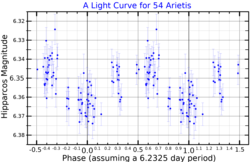Astronomy:54 Arietis
| Observation data Equinox J2000.0]] (ICRS) | |
|---|---|
| Constellation | Aries |
| Right ascension | 03h 08m 21.10890s[2] |
| Declination | +18° 47′ 42.1886″[2] |
| Apparent magnitude (V) | 6.27[3] |
| Characteristics | |
| Evolutionary stage | AGB[4] |
| Spectral type | M0 III[5] |
| B−V color index | 1.560±0.014[6] |
| Astrometry | |
| Radial velocity (Rv) | +44.32±0.22[2] km/s |
| Proper motion (μ) | RA: +38.133[2] mas/yr Dec.: −14.295[2] mas/yr |
| Parallax (π) | 4.3947 ± 0.1037[2] mas |
| Distance | 740 ± 20 ly (228 ± 5 pc) |
| Absolute magnitude (MV) | −0.54[6] |
| Details | |
| Radius | 40.7+3.0 −2.6[2] R☉ |
| Luminosity | 387±11[2] L☉ |
| Temperature | 4013+137 −141[2] K |
| Other designations | |
| Database references | |
| SIMBAD | data |
54 Arietis is a star in the northern zodiac constellation of Aries. 54 Arietis is the Flamsteed designation. It is a challenge to view with the naked eye even under good viewing conditions, having an apparent visual magnitude of 6.27.[3] Based upon an annual parallax shift of 4.39 mas, it is located approximately 740 light-years (230 parsecs) distant from Earth, and it is drifting further away with a radial velocity of +44 km/s.[2] The brightness of the star is diminished by 0.15[8] in magnitude from extinction caused by interstellar gas and dust. The star is positioned near the ecliptic and thus is subject to lunar occultations.[9]
This is an aging red giant star with a stellar classification of M0 III[5] that is currently evolving along the asymptotic giant branch.[4] Having exhausted the supply of hydrogen at its core, the star has expanded to 41[2] times the Sun's radius. It varies slightly in brightness, with a periodicity of 6.2 days and an amplitude change of 0.0096 in magnitude.[5] On average it is radiating 387[2] times the luminosity of the Sun from its enlarged photosphere at an effective temperature of 4,013 K.[2]
References
- ↑ "/ftp/cats/more/HIP/cdroms/cats". Strasbourg astronomical Data Center. https://cdsarc.cds.unistra.fr/viz-bin/ftp-index?/ftp/cats/more/HIP/cdroms/cats.
- ↑ 2.00 2.01 2.02 2.03 2.04 2.05 2.06 2.07 2.08 2.09 2.10 2.11 2.12 Brown, A. G. A. (August 2018). "Gaia Data Release 2: Summary of the contents and survey properties". Astronomy & Astrophysics 616: A1. doi:10.1051/0004-6361/201833051. Bibcode: 2018A&A...616A...1G. Gaia DR2 record for this source at VizieR.
- ↑ 3.0 3.1 Argue, A. N. (1966), "UBV photometry of 550 F, G and K type stars", Monthly Notices of the Royal Astronomical Society 133 (4): 475–493, doi:10.1093/mnras/133.4.475, Bibcode: 1966MNRAS.133..475A.
- ↑ 4.0 4.1 Eggen, Olin J. (July 1992), "Asymptotic giant branch stars near the sun", Astronomical Journal 104 (1): 275–313, doi:10.1086/116239, Bibcode: 1992AJ....104..275E.
- ↑ 5.0 5.1 5.2 Koen, Chris; Eyer, Laurent (March 2002), "New periodic variables from the Hipparcos epoch photometry", Monthly Notices of the Royal Astronomical Society 331 (1): 45–59, doi:10.1046/j.1365-8711.2002.05150.x, Bibcode: 2002MNRAS.331...45K.
- ↑ 6.0 6.1 Anderson, E.; Francis, Ch. (2012), "XHIP: An extended hipparcos compilation", Astronomy Letters 38 (5): 331, doi:10.1134/S1063773712050015, Bibcode: 2012AstL...38..331A.
- ↑ "54 Ari". SIMBAD. Centre de données astronomiques de Strasbourg. http://simbad.u-strasbg.fr/simbad/sim-basic?Ident=54+Ari.
- ↑ Famaey, B. et al. (January 2005), "Local kinematics of K and M giants from CORAVEL/Hipparcos/Tycho-2 data. Revisiting the concept of superclusters", Astronomy and Astrophysics 430: 165–186, doi:10.1051/0004-6361:20041272, Bibcode: 2005A&A...430..165F.
- ↑ Eitter, J. J.; Beavers, W. I. (June 1979), "Lunar occultation summary. III", Astrophysical Journal Supplement Series 40: 475–486, doi:10.1086/190595, Bibcode: 1979ApJS...40..475E. See event #419 for example.
External links
 |


